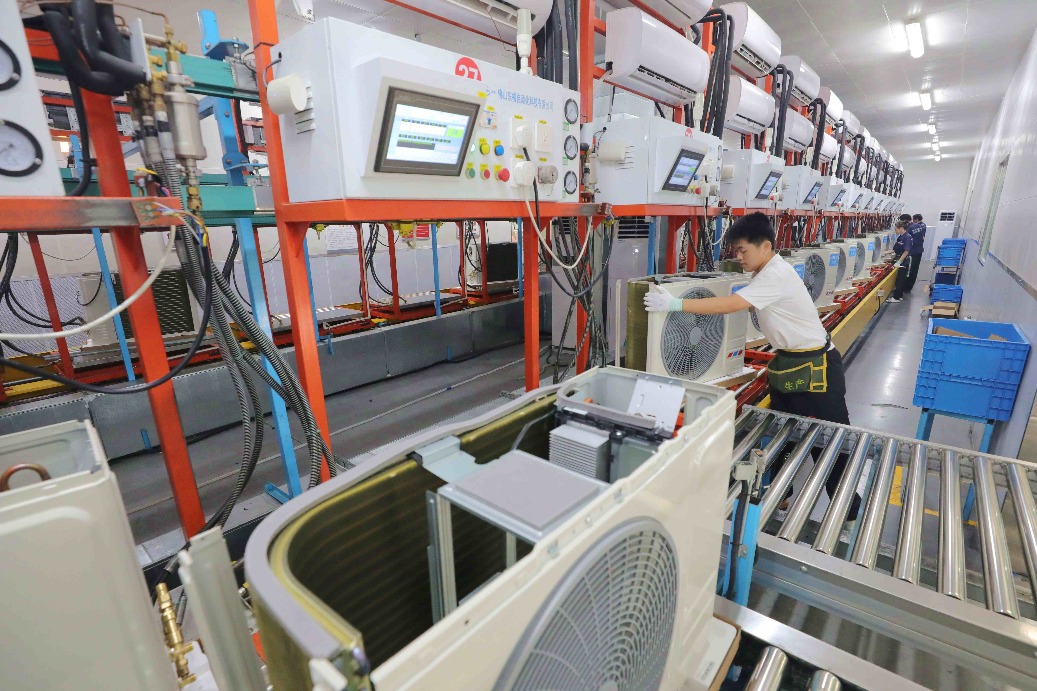Smaller cities help bolster urbanization


Policies encouraging talent attraction, industrial transformation called crucial
While China's megacities garner a great deal of attention, the country's up-and-coming midsize and smaller cities are growing and prospering thanks to helpful policies and innovative companies, officials said.
Cixi, Zhejiang province, which has a growing industry that specializes in small household appliances, made it onto the list of the 105 largest cities across the country with 1.83 million residents in 2020, according to a census report published by the State Council, China's Cabinet, recently.
One of the city's companies, Ningbo Fanpu Intelligent Technology Co, has seen its sales grow from less than 100 million yuan ($14.02 million) in 2009 to more than 700 million in 2021, according to Shen Ze, the company's chairman.
The company, which specializes in research and development, manufacturing and marketing of small household appliances, has grown quickly since it joined the retail e-commerce boom in 2010, Shen told China Daily.
Shen's company is among the many that have benefited from a friendly business environment supported by policies that encourage the attraction of young talent and industrial transformation, which are key drivers for the city's development and urbanization.
"In recent years, Cixi has been developing rapidly, with a large number of newly established companies shifting from the original focus on traditional home appliances to more technology-based enterprises," said Tao Linshan, general manager of Ningbo Zhechuang Technology Co, a company engaged in R&D and production of three-dimensional manufacturing materials and equipment in Cixi.
"At the same time, a series of talent introduction measures have helped make it possible for promising employees and projects to land in Cixi," Tao added.
Among the policies that have helped cities like Cixi grow are employment subsidies for graduates of the world's top 100 universities, and for living expenses and housing, local officials said.
Financial incentives are also provided for many high-tech companies to accelerate innovation and the use and development of 5G, big data, cloud computing, blockchain, artificial intelligence, industrial control security and other new-generation information technologies, they said.
In 2021, Cixi generated a GDP value of 237.9 billion yuan, making it sixth among the top 10 counties in the nation. Cixi is a county-level city under the jurisdiction of the sub-provincial city of Ningbo, in the north of Zhejiang province.
Now, the number of business entities in Cixi has exceeded 195,600, ranking first in Ningbo. There are 59,500 private enterprises, and very small or individually owned businesses numbered 136,100.
Yiwu, a county-level city under the jurisdiction of Jinhua in central Zhejiang, is also on the list of the 105 largest cities across the country. Yiwu has seen rapid growth in import, export and e-commerce transactions in the past decade.
From 2012 to 2021, the value of Yiwu's imports and exports jumped from 59.08 billion yuan to 390.3 billion yuan. The value of imports alone grew from 2.28 billion yuan to 24.39 billion yuan.
In Jiangsu, Zhejiang's neighboring province, Kunshan is also on the list of the 105 largest cities. Kunshan's economy generated a GDP value of 474.8 billion yuan in 2021, making it first among the country's top 100 county-level economies for 17 consecutive years.
Kunshan's population of over 2 million, including a high proportion of permanent urban residents, propelled the city into the ranks of large cities, the National Bureau of Statistics reported, based on the Seventh National Population Census released in 2021.
The city's well-developed economy has helped it attract many new residents, officials said. Last year, the city's per capita GDP reached 226,900 yuan, 2.8 times the national average and higher than that of very large Chinese cities such as Shanghai and Suzhou.
Hu Hanhui, director of Southeast University's research center for industrial organization, said that Kunshan has been working diligently and creatively to achieve such progress.
"For example, it started from the very beginning to develop an electronic information industry," Hu said. "The industry developed step by step and eventually became a leader. The spirit should be learned by any other city that seeks better development.
"The direction of China's urbanization must be the combined development of an urban and rural system with Chinese characteristics.
"County-level cities should value opening-up in the economy, select industries suitable for themselves, and focus on integrating into regional and international development," he said.
Kunshan officials said the city has always valued opening-up. The city's thriving electronics manufacturing industry began to receive foreign investment in the 1990s. Last year, its foreign trade surpassed $100 billion.
Zhou Wei, Party secretary of Kunshan, said the city's advantage in supply chains represents its biggest strength in attracting foreign capital.
"The reason we have been able to maintain about one-third of the global notebook computer manufacturing market is that we have always insisted on building a complete industrial chain," Zhou said in an interview at the recent 20th National Congress of the Communist Party of China.
As of now, the number of high-tech enterprises in Kunshan has increased from 385 in 2012 to 2,264, ranking first among China's county-level economies.
Kunshan has continued to attract science and technology talent and has established 40 joint cooperation offices and technology transfer centers with prominent Chinese educational institutions such as Tsinghua and Wuhan universities.
Another one on the top 100 county-level economies list is Jinjiang in Fujian province. Jinjiang's exports increased 231 percent in 10 years, from 26.89 billion yuan in 2012 to 89.02 billion yuan in 2021, with an average annual growth of 14.23 percent, according to the Jinjiang Municipal Bureau of Commerce.
Anta Sports Products Ltd, located in Jinjiang, has seen strong growth both in revenue and profits, ranking among the top three sportswear brands in the world by market valuation, propelled by its multiple-brand strategy. Thirty years ago, however, it was just a small workshop.
Ding Shizhong, chairman of the board of directors of Anta Group, said that the secret to the company's success lies in adhering to the real economy at all times.
Anta has concentrated on technological innovation and industrial upgrading in recent years, company officials said. It has set up five major R&D centers around the world and filed more than 2,000 national patents to drive high-quality development.
Experts have cited the four county-level cities, each having a permanent residential population between 1 million and 3 million, as examples of China's urbanization strategy, which focuses on small and medium-sized cities.
The cities have accepted more newcomers from rural areas to both ease the burden on the largest cities and balance national development. Dozens of other cities with slightly lower populations and labor-intensive industries have also helped move China's urbanization process forward.
In December 2019, Chinese government issued a guideline to step up reform to improve the social mobility of the labor force in general and those with special talent and skills, specifically.
The guideline stated that more efforts are needed to influence regional mobility via the household registration system and public services. It called for completely lifting restrictions on residence registration for cities with a residential population of less than three million in urban areas. It also called for relaxation of conditions for residential settlement for large cities with a population of 3 million to 5 million in urban areas. The settlement policies for megacities with a residential population of more than 5 million in urban areas are to be improved.
Fang Xiaoying and Guo Jun contributed to this story.




































